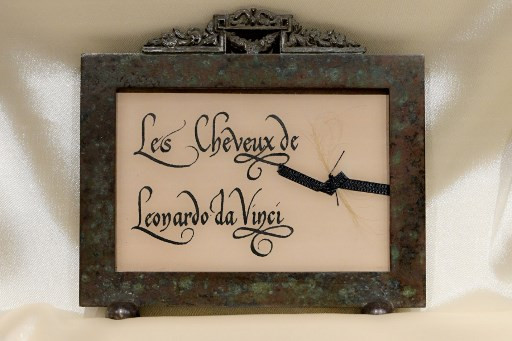Popular Reads
Top Results
Can't find what you're looking for?
View all search resultsPopular Reads
Top Results
Can't find what you're looking for?
View all search resultsExperts comb through DNA from possible Da Vinci hair
A lock of what some historians think is Leonardo da Vinci's hair went on display at a museum in his Tuscan birthplace as they seek to prove it contains his DNA 500 years after the genius died.
Change text size
Gift Premium Articles
to Anyone
A
lock of what some historians think is Leonardo da Vinci's hair went on display Thursday at a museum in his Tuscan birthplace as they seek to prove it contains his DNA 500 years after the genius died.
Presenting what he called a "relic" at the Leonardo library in Vinci devoted to the painter and Renaissance giant, art historian Alessandro Vezzosi told AFP how the whitish-blond hairs emerged from the shadows.
"This lock remained secret for a long time before we discovered it three years ago in the United States," he said.
"It will allow us to do DNA research on Leonardo," Vezzosi added.
"After studying Da Vinci's genaeology for 40 years, in 2016 we presented 35 living descendants of the master, and a short time later I was contacted by the collector who owns it and who agreed to show it."
Leonardo da Vinci was born April 15, 1452, in Vinci, northwest of Florence, the illegitimate son of a wealthy landowner and a teenaged peasant.
He died May 2, 1519, in Amboise, central France, where he had lived as the guest of King Francis I.
Leonardo had no children but he had a dozen half-siblings on his father's side and several more on his mother's side.
Less than a decade later, Leonardo's patron left the Loire Valley for Paris and Fontainebleau. Although the chateau would again become a royal seat, it gradually fell into decline.
Vezzosi chose the symbolic 500th anniversary of his death to present the lock of hair as part of the "Leonardo Lives" exhibition curated with Agnese Sabato.
The lock is accompanied by a notice reading "The hair of Leonardo da Vinci" in French, along with a bronze ring that documents describe as having been worn by the Florentine genius.
Read also: At Amboise, Leonardo's last years paint a picture of Franco-Italian harmony
Living descendants
"We are not 100 percent sure it is his hair, we are saying it is possible through genaeological research to compare the genetic material's DNA with that of Leonardo's living descendants who have been found in Tuscany," Vezzosi said.
Other comparisons are to be made with material recovered from tombs in France and Spain, the Renaissance specialist added.
Eike Schmidt of the Uffizi Gallery in Florence doubts the hair is authentic, however.
"No specialist thinks so, and it is extremely unlikely that a lock of Leonardo's hair could wind up in an American collection," he told Italian media on Thursday.
"The tradition of collecting locks of famous people's hair dates from the Romantic period, in the 19th century," Schmidt said.
Vezzosi said it was known that the relics presented in Vinci belonged to French writer Arsene Houssaye, a museum director who discovered a stone coffin during an excavation in 1863 at Amboise's royal chateau in the Loire Valley.
Inside he found a skeleton whose right hand was placed behind its head along with stone fragments on which were inscribed -EO -AR -DUS -VINC- and French and Italian medals that dated from early in the reign of Francois I.
There were also a few bits of a beard, and white hairs.
Leonardo spent the last three years of his life in France at the invitation of the French king, a patron of the arts keen to support the Italian master's vast talents.
The Renaissance master died at the age of 67 and according to the terms of his will, was buried at the chateau's chapel, which was destroyed in 1807 -- with authorities apparently unaware that Leonardo was buried there.
The unidentified bones turned up during Houssaye's excavation and were interred in 1874 at chapel of Saint Hubert, with plaques in French and Italian stating they are the "presumed remains" of the Renaissance master.
Those remains are to be left untroubled now as experts try to determine if the hair is genuine, because disturbing them "might be seen as a profanation", Vezzosi said.
"With the living descendants and tombs of descendants we are able to make comparisons without troubling the tomb (of Leonardo) which is a site of historical and symbolic signification to be respected," the historian said.
He plans to present the results of his research within a few months.











